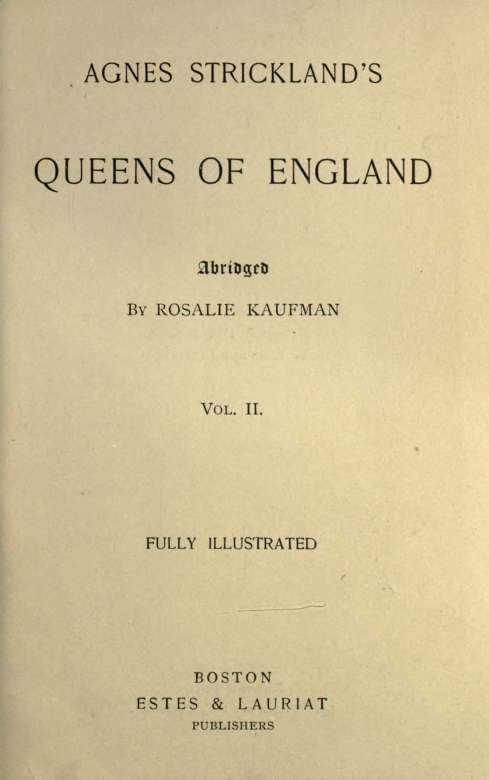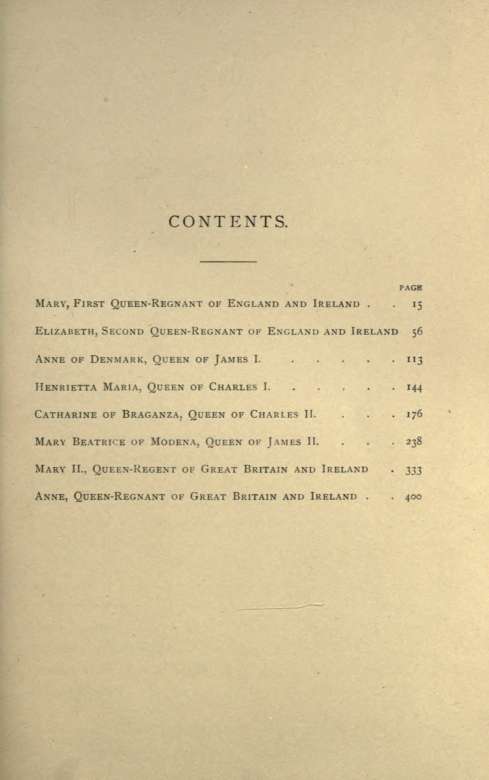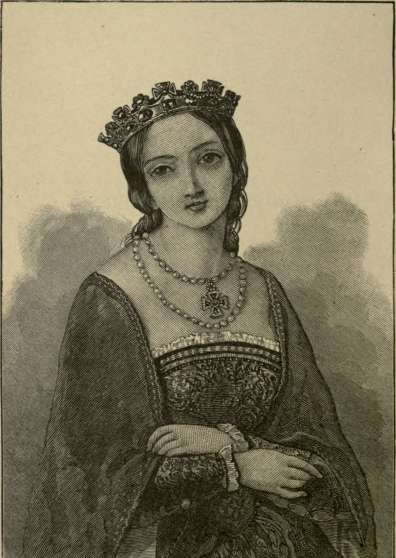Agnes Strickland's Queens of England
Read Agnes Strickland's Queens of England Online
Authors: 1796-1874 Agnes Strickland,1794-1875 Elizabeth Strickland,Rosalie Kaufman
Tags: #Queens -- Great Britain

This book made available by the Internet Archive.



stack AnnM
M
PREFACE.
Up to Queen Anne, this work is based upon Agnes Strickland's "Queens of England;" but subsequent to that period many authorities have been consulted, and only such matter used as would seem appropriate. My first care was to prepare a narrative which should interest young people, but I have endeavored also to produce a result that would prove a source, not only of pleasure, but of profit. The limits of the design make it evident that some eminent names and noteworthy events could receive slight mention, or none at all, and that politics could be introduced only when requisite for the comprehension of events that depended on them. It will be a satisfaction to hope that my readers may be prompted to independent inquiry.
R. K.

Park at Stowe Frontispiece
Mary, First Queen-Kegnant of England 14
Edward VI 25
Mary refuses to give up Mass 28
Lady Jane Grey 33
Queen Mary plights her troth to Philip 49
Death of Latimer and Ridley 53
Queen Elizabeth 57
Cranmer 59
London Street — Rainy Day in time of Elizabeth .... 65
Old Palace at Hatfield 70
St. James Park , . . . 79
Mar}' Stuart ... 87
Sir Walter Raleigh 95
Mary's Chamber 98
Distniction of the Armada . . . : 103
Elizabeth boxing Essex on the Ear 107
Anne of Denmark Ill
I'AGE
Door to Holyrood 115
Castle of Edinburgh 123
The Piscina 131
Drawing-room at Winchester . . 136
Execution of Sir Walter Raleigh 141
Henrietta Maria 145
Chateau Fontainebleau 149
The Plague 153
Maple-Durham Church and Mill 163
Catharine of Braganza 179
Cathedral of Guimaraes ....... . . 187
Queen's Bed 199
The Oratory 207
King's Apartment 209
Great Fire in London • . -215
Charles II 221
Chapel in the Tower 227
The Queen's Bower 230
View of Oporto 233
Mary Beatrice 239
Grande Monarcjue 247
Versailles 2;i
The H6tel de Ville 259
Holyrood 267
James T1 273
Duke of Monmouth 281
St. Germain 297
James at the Battle of the Boy no 303
Queen's Drawing-room 308
PAGB
Louis XIV. in Old Age 319
Mary II 331
William and Mary 341
Scene in Holland 347
Monument of William at the Hague 351
The Retreat 358
Entrance of William into London 369
Bentinck, Earl of Portland 380
Gardens of William HI 382
Duke and Duchess of Marlborough 391
Anne of England 401
Kensington Palace 405
Hunting Lodge 414
Chapel of Henry VH 427
William Thrown from hi"; Horse The Avon at Bristol
433 445
Hogarth's House 454
Windsor Forest
470
At Malplaquet . 477
Anger of the Duchess of Marlborough 481
Shrewsburv /eceWing the White Rod 495
STORIES OF THE LIVES
OF
THE QUEENS OF ENGLAND.
COMPILED FROM AGNES STRICKLAND, FOR YOUNG PEOPLE,
BY ROSALIE KAUFMAN.

MARY, FIRST QUEEN-REGNANT OI- ENGLAND.
THE
QUEENS OF ENGLAND.
• CHAPTER I.
MARY, FIRST QUEEN-REGNANT OF ENGLAND AND IRELAND. (A.D. 1516-1558).
Mary was the only child of Henry VHI. and Katharine of Arragon who lived to maturity. She was born at Greenwich Palace in 1516, and was placed under the care of her mother's beloved friend, Margaret Plantagenet, Countess of Salisbury.
[A.D. 1516.] She was baptized the third day after her birth, and named for the king's favorite sister.
Mary's mother began her education as soon as she could speak; and when she was only three years old she sat up in state to receive some foreign visitors, and amused them by playing on the virginals, a musical instrument similar to a piano. It was in a box about four feet long, with an ivory key-board of two or three octaves, and was placed on a table when played upon.
At that time Mary was a bright, merry child, with rosy complexion and brown eyes, and such a pet with her parents that she remained with them at Greenwich until after her fourth birthday.
[A.D. 1522.] While Mary was yet in her cradle a marriage was spoken of for her with Francis I., but her mother
was anxious to see her united to her own nephew, the Emperor Charles V., who paid a visit to the EngUsh court when he was about twenty-three years old. He was there nearly five weeks, during which the little princess became very fond of him, and, young as she was, learned to consider herself his empress.
He signed a solemn treaty at Windsor to marry her when she was twelve years old, but was desirous that she should be sent to Spain for her education. Her parents would not consent to the separation, but engaged the best instructors for her, and had a plan of study drawn up by a Spaniard of deep learning. His rules were rigid; he required the young princess to read religious works night and morning, to translate English into Latin frequently, and to converse in that language with her teacher. He implored her never to read books of chivalry or romance^ condemned a long list of light works as injurious to morals, and recommended instead Plato, Cicero, Seneca's Maxims, Plutarch, the works of Erasmus, Sir Thomas More's "Utopia," some of the classic poets, and the tragedies of Seneca. He deemed card-playing and fine dressing as injurious as romances, and gave rules for the pronunciation of Greek and Latin, requiring that lessons in those languages should be committed to memory every day, and read over two or three times before the pupil went to bed.
No wonder the poor child's health and spirits suffered, for she was only six years old when this system of education was enforced.
The Emperor Charles still continued to desire her to spend part of her time in Spain, but Henry VHL promised instead that she should be brought up in England like a Spanish lady, and should even wear the national dress of that ; ountry. He added, that nobody in all Christendo;i»
could be found to bring her up according to the customs of Spain better than her mother, who came of a noble house of that country, and, besides, that the princess was too young to undertake the voyage.
[A.D. 1525.] During the summer of 1525 a rumor reached England that Charles V. had engaged himself to Isabel of Portugal. This was little Mary's first sorrow, for her maids had persuaded her that she was really in love. But Charles had heard of the king's intention to divorce his wife and disinherit his daughter, and was excessively angry; in consequence, he thought best to revenge himself on Mary. He wrote a letter filled with reproaches to Henry, and married Isabel before the end of the year.
Then Mary, though only nine years of age, was established in a court of her own at Ludlow Castle, in Wales. She had not been called Princess of Wales, but received the same honors as though she had.
The Welsh were pleased to have the royal family represented in their country, and the officers and nobles of Mary's court superintended the newly-formed legislature.
Sir John Dudley, afterwards Earl of Warwick, was her chamberlain, and the Countess of Salisbury resided with her, as she had done from her birth, as head of her establishment. There were, besides, thirteen ladies of honor, and a large number of other officers.
Few children are so lovely, bright, and well-behaved as Mary was at that time, when she had her first lessons in playing the part of queen, which she was so soon to unlearn. Probably Henry placed her in the position of heir-apparent of England, hoping that she would make a grand match before he disinherited her, otherwise there could be no reason for it, considering the poverty and contempt she r>ufTered later.
Her education went on steadily during the eighteen months she spent at Ludlow, and great care was taken of her exercise, diet, dress, and everything pertaining to her health and morals.
Her father made a desperate attempt to marry her to Francis I., but he was engaged to the widow of the King of Portugal, besides he was by no means anxious to marry a girl eleven years of age.
Spite of the methodical course of Mary's education she took part in the revelry at her father's court when she was not more than eleven years old, and danced a ballet with seven other ladies and eight lords. She also performed in one of Terence's comedies in the original Latin for the entertainment of the French ambassadors when they were at Hampton Court.
[A.D. 1529.] Her misfortunes dated from that period, for it was then that her mother's divorce began to be publicly discussed.
Katherine was anxious to marry her daughter to Reginald Pole, son of the Countess of Salisbury, but he had no desire to connect himself with the English court, though he was always fond of Mary, and gave as excuse that he had been educated for the church, though he never became either a priest or a monk. He did not hesitate to express to the king his entire disapproval of the pending divorce, and thus incurred the royal displeasure to such a degree that he was obliged to leave England.
For a long time Mary had been her mother's daily companion, but when she was about fifteen years of age she was separated from her, never to behold her again. This was such a source of grief to the young girl that she became seriously ill on account of it. Katherine wrote her daughter loving letters, and tried to console her for the loss of her instruction in Latin by assuring her that Dr.
Fetherstone was a much better teacher, but she never complained of the cause of their separation in any of her correspondence.
[A.D. 1532.] It was not until after the birth of Elizabeth that the king disinherited his daughter Mary, and declared her half-sister his heiress. Then orders were sent to her to lay aside the name and dignity of princess and remove to Hatfield, where the nursery of her infant sister was about to be established.
Mary was but seventeen at this time, but she showed a good deal of courage, when she told the messenger that she should not take the slightest notice of the order unless it were delivered to her in the king's own hand and bore his signature.
Then she wrote a private letter to her father, asking him whether he really meant to deprive her of her title. He did not condescend to reply, but a couple of months later her household, consisting of no less than three hundred and sixty persons, was suddenly broken up, and the poor girl was separated from the Countess of Salisbury and others, to whose society she had been accustomed during her whole life.
This was a blow far more bitter than being deprived of her title. Another trial it was to find herself no more than a dependent in her sister's household, which was fitted up with the magnificence she herself had just been robbed of. The comparison that she was daily forced to draw between the position of her infant sister and her own was enough to make her hate the child, but, strange to say, her affection for it was strong; and good Margaret Bryan, who had been her nurse, and was now performing the same service for Elizabeth, did all in her power to soothe the mind of her former charge, and encourage kindly feelings for her little sister.
Mary spent two years of sorrow and suffering at Hatfield Castle, where her stepmother treated her with extreme un-kindness, and during that time several persons were sent to the Tower for calling her " Princess." This no doubt added greatly to her unhappiness. Besides, she was closely watched, and although allowed to read and study, writing was forbidden until after the death of Anne Boleyn, when in one of her letters she apologized for her bad penmanship on the ground that she had had no practice for two years.
[A.D. 1535.] Her position was so dreadful that most people pitied her, and the king was heard to mutter such harsh threats against her that it would not have occasioned much surprise if her head had been brought to the block. Her dying mother begged that she might have the satisfaction of knowing that Mary was near her, even though she were not permitted to see her, but the tyrant Henr}-refused, though the poor girl's health was suffering for want of her mother's tender care and affection. Even the sad satisfaction of a last farewell between the dying queen and her only child was forbidden, and Katherine of Arragon departed from this world without laying eyes on her daughter.
Mary wrote her father a congratulatory letter when he married Jane Seymour, but he took no notice of it, nor addressed her in any way until she was requested through his privy councillor to sign a paper renouncing all right to the throne. She could not have been induced to do this while her mother lived, but she was so broken down from sorrow and ill health that she no longer had the power to resist.
Then she was settled again in a household, with her little sister, at Hunsdon, which, though comfortable and peaceful, was poor and humble compared with what she had
enjoyed at Ludlow Castle. Mary was her own mistress there for three years, and spent most of the time in study, dividing off her day as she had been taught to do when under her mother's care. She studied astronomy, geography, natural philosophy, and mathematics, as well as Latin and Greek authors; read the church service daily with her chaplain, did a good deal of needle-work, and practised on three musical instruments. Latin was the universal language, so she spoke it with ease, and could read and write French, Spanish, and Italian besides.
[A.D. 1537.] She was not admitted to her father's presence until 1537, when, strange to say, although her tastes were refined, and her life a busy one, her journal contained items of high play at cards, and a fondness for betting and gambling, which was one of the vices of Henry's court, he himself being one of the greatest gamblers that ever wore a crown.